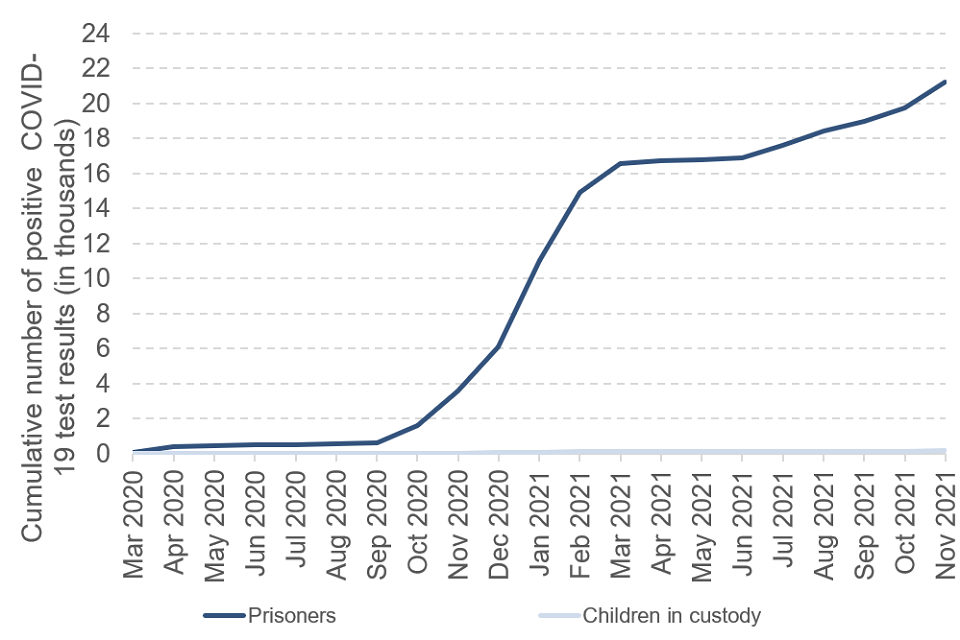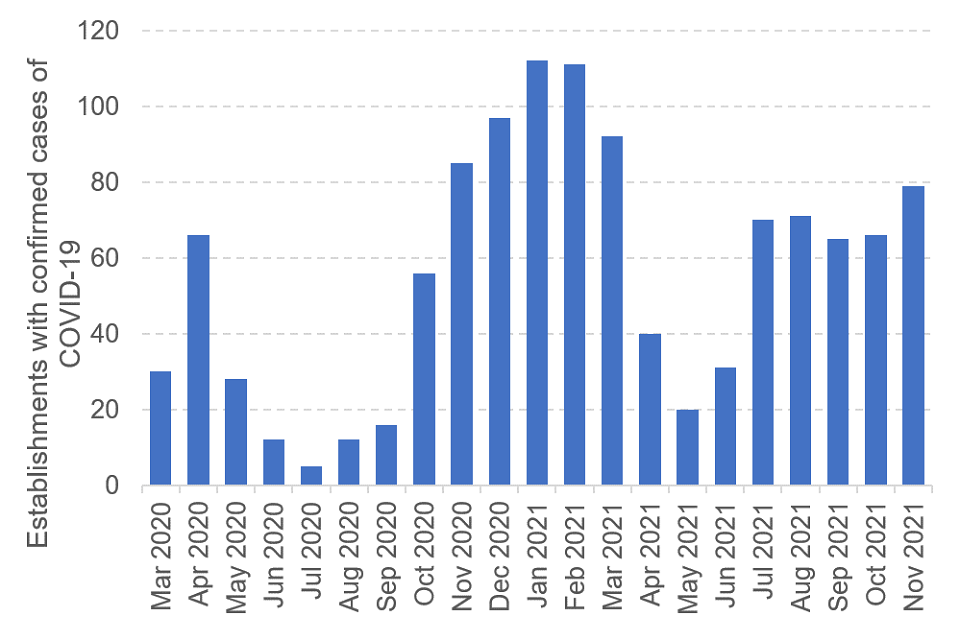HM Prison and Probation Service COVID-19 Statistics, November 2021
Published 10 December 2021
HM Prison and Probation Service COVID-19 Official Statistics
Data to 30 November 2021
Ministry of Justice
Published 10 December 2021
Introduction
This official statistics release provides monthly data on the spread of COVID-19 in the prison and probation service in England and Wales and mitigating actions being taken to limit the spread of the virus and save lives. This release covers the period from Monday 16 March 2020 at the start of the COVID-19 outbreak to 30 November 2021.
It provides information on:
-
Deaths where prisoners, children in custody or supervised individuals have died having tested positive within 28 days of the death or where there was a clinical assessment COVID-19 was a contributory factor in their death regardless of cause of death.
-
Confirmed COVID-19 cases in prisoners and children in custody (i.e. positive tests).
-
Narrative on capacity management data for prisons.
Key Findings
The key findings in this release are:
-
249 prisoners and supervised individuals have died having tested positive within 28 days of death or where there was a clinical assessment COVID-19 was a contributory factor in their death. Of whom 169 were prisoners and 80 were individuals supervised by the probation service. There were 11 deaths in November 2021.
-
Of the 249 deaths, 218 were suspected or confirmed to be caused by COVID-19, 142 were prisoners and 76 were supervised individuals.
-
21,373 prisoners or children in custody have tested positive for COVID-19 since the start of the pandemic, across 128 establishments, almost all of whom were adults.
-
There were 1,484 new confirmed cases in November 2021, which is an increase of 698 compared to October 2021.
-
79 establishments had prisoners or children testing positive in November 2021, 13 more than October 2021.
Background
Since the start of the COVID-19 pandemic, there has been keen public and Parliamentary interest in how the Ministry of Justice (MOJ) and Her Majesty’s Prison and Probation Service (HMPPS) are managing the running of prisons and the probation system to limit the spread of the virus while maintaining the core functions of these vital parts of the justice system. Publishing this data aims to bring transparency to the strategies HMPPS is employing to manage the prison and probation systems, as well as the impact of the virus on the individuals in the care of HMPPS and staff.
The core tenet of HMPPS’s prison strategy, building on Public Health England (PHE) and Public Health Wales (PHW) advice and learning developed in managing an early outbreak of the virus, is the implementation of effective isolation, reverse cohorting of new entrants to custody, and shielding of vulnerable prisoners.
1. Capacity management
As at 26 November 2021, the prison population was 79,700, showing a reduction of 4,200 since 13 March 2020[footnote 1]. Whilst total population has reduced, the remand population has increased during the pandemic, mostly due to the challenges in holding Crown Court trials during this period.
HMPPS have adopted a capacity management approach known as ‘compartmentalisation’. This involves the isolation of all prisoners with symptoms, the shielding of clinically vulnerable prisoners in the system and all new arrivals being quarantined for 14 days. These measures minimise the risk of infection spreading throughout prisons, but also impact prison capacity.
The strategy is being kept under ongoing review and regularly adapted in response to operational learning as well as evolving pandemic risks in the community. There is a balance between effective infection control and maintaining a commitment to support prisoners through their custodial sentence and help them access appropriate services.
2. Deaths
The service has taken the measures outlined to limit the spread of the virus and to protect staff and individuals in the care of HMPPS. However, prisons and probation, like all other sectors in the England in Wales have experienced deaths due to COVID-19.
The counting of deaths in prisons and probation are aligned to the Public Health England definition, and reports on deaths where the individual had tested positive for COVID-19 or where there was a clinical assessment that COVID-19 was a contributory factor in their death. This consists of:
-
Deaths suspected or confirmed to be due to COVID-19
-
Deaths believed to be due to other causes, but where the individual had tested positive for COVID-19.
From March 2020 to the end of November 2021, 249 individuals in the care of HMPPS died having tested positive for COVID-19 within 28 days of death or where it was confirmed post-mortem as a contributing factor. 169 were prisoners. There were no deaths of children in custody. 80 of the 249 individuals were being supervised in the community[footnote 2]. Figure 1 shows the cumulative number of prisoner and supervised individual deaths since March 2020.
Figure 1: Cumulative number of individuals in the care of HMPPS who have died testing positive within 28 days of the death or where it was confirmed post-mortem, England and Wales, monthly from March 2020 (Source: Summary Tables, Table 1)

55 deaths occurred before July 2020, 165 deaths between October 2020 and April 2021 and 29 deaths have occurred since July 2021. There were no deaths of individuals in the care of HMPPS during May 2021 and June 2021, before the total number of cases started to rise again in July 2021. There were 11 deaths in November 2021. The cumulative total increased by 13 deaths this month due to 2 additional deaths occurring in September which have since been confirmed to be due to COVID-19.
Of the 169 prisoner deaths, 142 are suspected or confirmed to be due to COVID-19. The remaining 27 deaths are believed to be due to other causes, although the individuals had tested positive for COVID-19. Of the 80 individuals under probation supervision who have died, 76 are suspected or confirmed to be due to COVID-19 with the remaining 4 believed to be due to other causes, but where the individual has tested positive for COVID-19.
The cause of death in each case is provisional until the official cause of death has been determined by the coroner. As such revisions may be made to the data as part of this process.
Data relating to the deaths of prison and probation officers to 30 September 2021 have been published in the HMPPS Workforce Statistics.
Data relating to the deaths of service users have also been published in the National Statistics report Safety in Custody and in the official statistics report Deaths of Offenders in the Community.
3. Testing
Testing practices in prisons and Youth Custody Service (YCS) sites have been determined locally. Initially, once a small sample of prisoners or children had tested positive in an establishment, no further tests were carried out on symptomatic individuals to preserve testing kits and on the assumption all further tests would be positive. This policy was changed on 15 April 2020 due to the increased availability of testing supplies meaning all symptomatic prisoners or children are now tested. As such data trends should be considered with caution and do not represent true like-for-like comparisons.
In the period to 30 November 2021, a cumulative total of 21,373 prisoners or children tested positive for COVID-19 across 128 establishments. Less than 1% (159) of these positive tests were children. There were 1,484 new confirmed cases in November 2021, which is an increase of 698 compared to October 2021. Figure 2 shows the cumulative monthly individuals testing positive for COVID-19 to the end of October 2021.
Figure 2: Cumulative number of prisoners and children in custody testing positive for COVID-19, England and Wales, monthly from March 2020 (Source: Summary Tables, Table 2).

79 establishments had prisoners or children testing positive during November 2021, 13 more than in October 2021. Figure 3 shows the monthly number of establishments with prisoners or children in custody testing positive since March 2020.
Figure 3: Number of Prison or Youth Custody Service establishments with prisoners or children in custody testing positive for COVID-19, England and Wales, monthly from March 2020 (Source: Summary Tables, Table 2).

Recognising the unique environment in prisons, HMPPS now routinely test staff and offenders to bolster defences against the virus – to identify and isolate cases earlier and move quickly to contain outbreaks, protect local NHS and save lives.
HMPPS has been working closely with the Department of Health and Social Care, the NHS, and health authority colleagues in England and Wales for over a year on providing access to COVID-19 tests in a prison environment. Initially, this involved the testing of symptomatic prisoners; then during summer 2020 the testing of all consenting prisoners commenced, along with HMPPS employees and non-directly employed staff across 28 prisons in England.
During Autumn 2020, additional testing capacity was made available to limit the importation of infection into prisons. This includes the regular testing of staff across all prisons and carrying out the asymptomatic testing of new receptions to stop the virus spreading into and between prisons. Lateral Flow Device (LFD) testing has been introduced to supplement the existing current PCR testing and is available for all staff attending the workplace and for prisoners the introduction of LFD testing for receptions, transfer, release, pre-court attendance and release on temporary licence. Furthermore, additional testing has been introduced for staff who are double vaccinated and contact traced, to provide additional risk mitigation when they return to work. We continue to work with our health partners as new variants of COVID-19 are identified and review our testing strategy where necessary.
Data Quality
Although care is taken when processing and analysing the returns, the detail collected is subject to the inaccuracies inherent in any large-scale recording system. Any inaccuracies may result in revisions of previously published information in future releases. Much of the data collected during the COVID-19 pandemic has been done at pace, with recording practices evolving as we understand more about the requirements and conditions we are facing. In order to present the timeliest information, the data presented in this report have not been subjected to the usual standard of quality assurance associated with official statistics.
Much of the data will undergo additional assurance in due course and be reported as official statistics in the following releases:
All deaths are phoned into MOJ headquarters on a daily basis. The cause of deaths in prison are classified as apparent until a police investigation and coroner’s inquest have been concluded and the Prisons and Probation Ombudsman’s office publish a detailed ‘Fatal Incident Report’. Recording practices for COVID-19 related deaths have been updated since the start of the pandemic, meaning the exact cause is not always available or known. Furthermore, the cause of many deaths will be uncertain and awaiting an inquest; we have taken steps to reflect this uncertainty by reporting all cases in which COVID-19 was suspected to be a factor.
Contact points
Press enquiries should be directed to the Ministry of Justice press office:
Email: PressOfficePrisonsDesk@justice.gov.uk
Tel: 020 3334 3536
Other enquiries about these statistics should be directed to:
Rory Heard
Email: PPRWS_Correspondence@justice.gov.uk
Next update: 14 January 2022
© Crown copyright
Produced by the Ministry of Justice
Alternative formats are available on request from PPRWS_Correspondence@justice.gov.uk
-
Prison population figures can be found at https://www.gov.uk/government/statistics/prison-population-figures-2021 ↩
-
On the 26 June 2021 the National Probation Service was renamed the Probation Service and took on responsibility for supervising low and medium risk offenders previously managed by Community and Rehabilitation Companies. ↩
